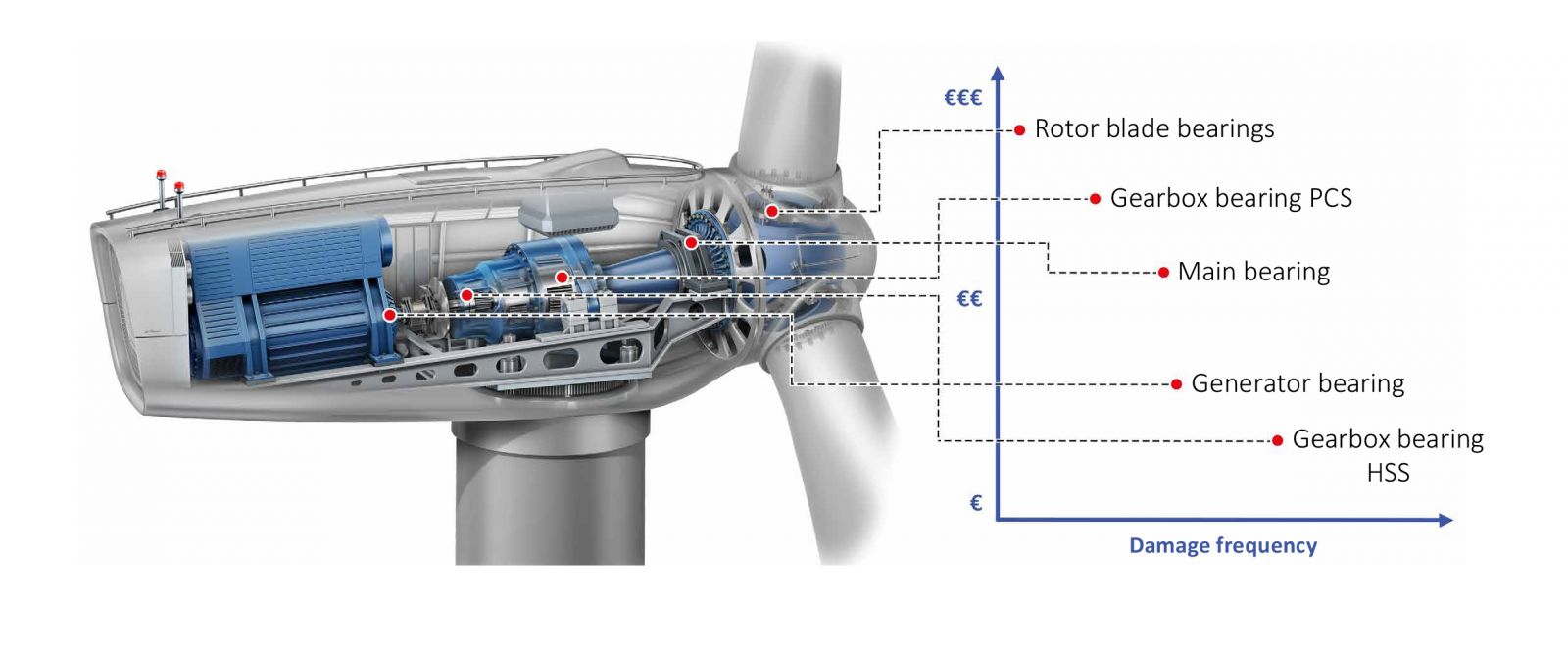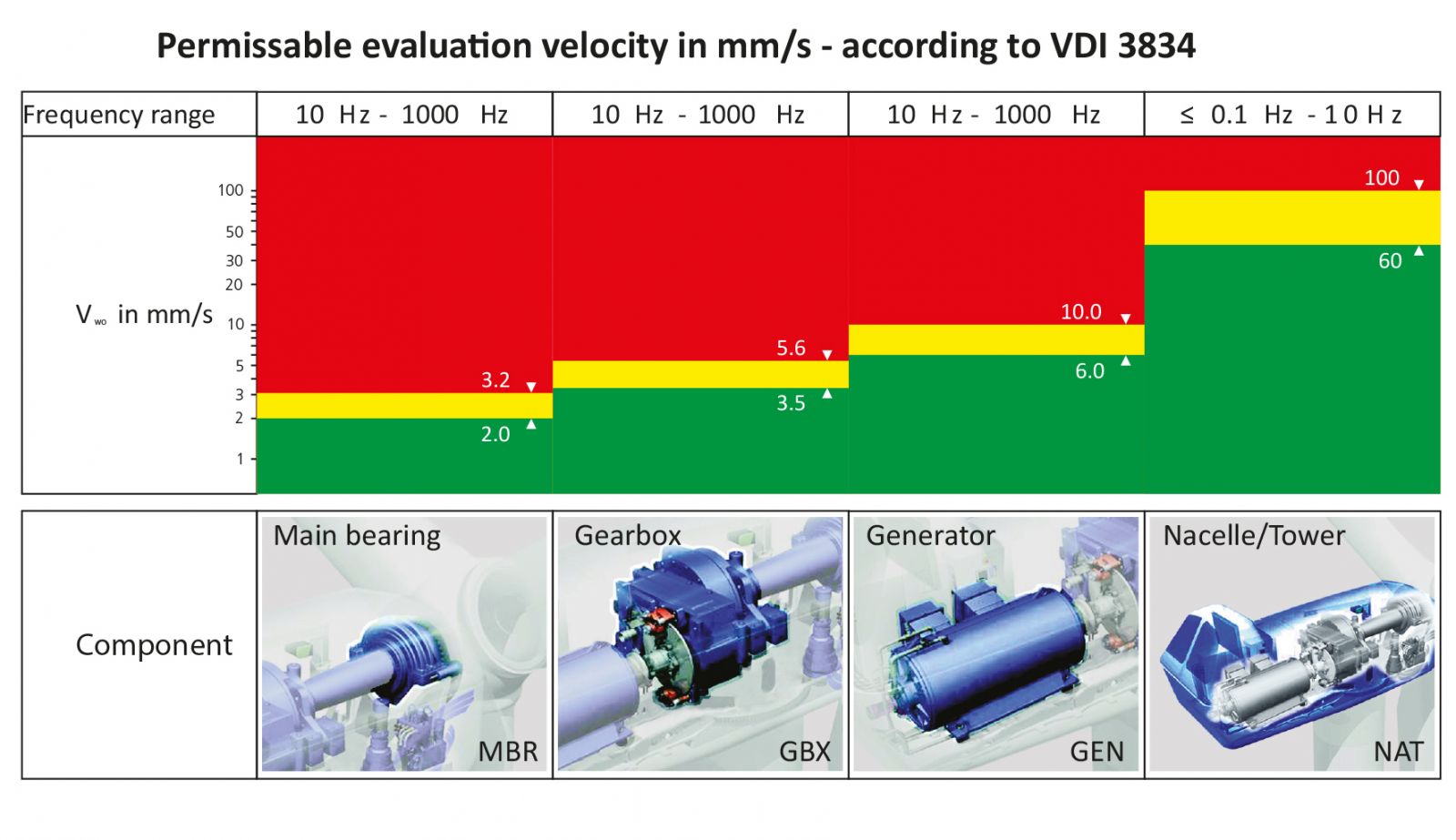How Remote Monitoring Can Increase Reliability
Using wired sensors for condition monitoring of wind turbine machinery and components isn’t http://new. However, continuous advancements in technology and connectivity powered by the Industrial Internet of Things let maintenance professionals strategically maximize historical and real-time data remotely, increasing wind turbine reliability and availability.
Today, operators can more easily get ahead of common wind turbine problems. Using years of cumulative wind up-tower and down-tower data, analysis experts can more accurately predict machine problems, such as bearing wear or damage, to prevent machine failure.

Figure 1. Bearing damage is one of the most common wind turbine problems. Historically, roller bearings cause the most frequent problems. (Image courtesy of Fluke Reliability)
Growth of remote condition monitoring services
According to the U.S. Department of Energy’s 2021 Wind Market Report, U.S. wind capacity reached a record 16,836 MW in 2020, for a total of 121,955 MW, and overtook solar power installations for the first time in many years. In 2021, China, the U.S., Germany, and India had the highest increase in wind capacity.
Because of the technological advancements in wind turbines and the increase in wind turbine installations globally, the demand for and value of remote condition monitoring systems continues to grow. This is especially true for vibration monitoring.
In 2015, the average age of a North American wind fleet was 5.5 years. In 2020, the average age was estimated to be seven years old, and fourteen years old by 2030. As a result, optimizing wind turbine performance to ensure regulatory compliance and life expectancy is critical, as is finding the most efficient ways to keep maintenance and operations costs down.

Figure 2. A wired advanced vibration analysis tool can measure and monitor a wind turbine’s main bearing, gearbox, generator, and nacelle. This graphic details vibration velocity levels according to VDI 3834 and ISO 10816-21 standards for component-specific frequency ranges, acceptable (green) and unacceptable (red). (Image courtesy Fluke Reliability)
Many maintenance teams lack the specialized condition monitoring and data analysis expertise to monitor an entire fleet constantly. That pushes organizations to enlist an external remote condition monitoring service to help wind farm operations decrease vibrations and up-tower maintenance reducing operations and maintenance expenses. Additionally, costs can be further reduced by adopting condition-based maintenance (CBM), a subset of predictive maintenance strategies wherein only relevant maintenance is performed based on machinery data and health.
Benefits of a remote condition monitoring service:
- Detects machine-related issues early
- Improves maintenance planning and scheduling
- Prevents unscheduled and costly downtime
- Extends equipment lifespan
- Reduces maintenance and production costs
Wind turbine remote condition monitoring services fill maintenance operations gaps
A lack of resources and on-premises data analysis experts often drives the need for partnering with an independent remote condition monitoring services company. Remote condition monitoring service companies continuously monitor wind turbine vibration data and provide expert analytical evaluations.
Some operations offer a complete solution beyond services that include hardware and software. This all-encompassing service model enhances a more cohesive relationship between providers and customers.
.jpg)
Figure 2. Powerful software provides insightful asset condition monitoring data enabling deep analysis (Image courtesy of Fluke Reliability)
Because wind fields are often in remote locations, information about a machine issue must be communicated quickly. Expediency is even more critical if the wind turbine is located offshore and has weather concerns.
Fault diagnosis expertise is necessary for identifying the type and location of the fault and determining the severity of the fault and time to failure. With a data-driven remote condition monitoring service, customers know which component is causing a problem and why. The provider’s experts make recommendations on fixing the problem based on condition monitoring data, and they offer advice on targeted vibration reduction.
Choosing a remote condition monitoring services provider
The extent of services a provider offers varies depending on their capabilities and experience. A remote condition monitoring service should include recurring analysis and reporting, status reports at periodic intervals, event-driven reports, and data management. Also, data should be accessible from anywhere, and the system should include a robust software system.
Ultimately, it should be apparent that the remote condition monitoring services provider possesses product, application, and industry expertise.
5 things to consider when choosing a remote condition monitoring services provider
- Monitoring & diagnosis certifications matter
The remote condition monitoring center should be certified and offer FMEA-based states diagnosis (Failure Mode and Effect Analysis). Ensure those performing your data monitoring and diagnosis are ISO CAT certified, i.e., monitoring specialists with ISO CAT I certification. Diagnosis specialists with ICO CAT II, III, and possibly ISO CAT IV certification.
- Impartial independent remote CM providers
The original equipment manufacturer (OEM) often provides remote condition monitoring services to its buyers. However, there can be drawbacks to using an OEM. When you partner with an independent services provider, you receive a fresh view of the machinery without preconceived notions about why a component experienced a fault. Their assessment of the machine’s health is based on data.
- Expertise and hands-on experience counts
When it comes to wind tower data diagnostics and analysis, the more experience your service provider has, the better. Look for a provider with a track record for solving wind turbine problems and one that understands the complexities of vibration analysis and fault diagnoses.
Make sure the service provider can show you years of proven expertise, knows wind turbine machinery inside and out, and that they understand your organization’s needs and goals.
- Consider a full-service solution and partner
A complete remote condition monitoring vibration system should include the hardware, as well as software and services. Your provider should be an integral part of your operations and someone you trust fully to keep your equipment up and running. If your company plans to expand its condition monitoring program in the future, look under the hood of the company you choose. Are they on top of technology? Will their devices integrate with others? They should be able to tell you how their service fits into your reliability journey now and into the future.
- Increase cost efficiency
There are a variety of ways that remote condition monitoring can help ensure a high return on your investment. One of the most obvious cost efficiencies from condition monitoring comes as wireless sensors reduce the need for route-based maintenance. A services provider should be able to offer different service levels to fit your needs and budget.
Michael Dietl works at Pruftechnik, part of the Fluke Reliability family, where he manages the Remote Monitoring & Diagnostics Services Team based in Munich, Germany. He has over ten years of experience in the wind industry sector and six years in remote condition monitoring and services for several industries. He holds a master’s degree in Environmental Engineering from the University of Stuttgart partnering with ETH Zurich and speaks English, German, and Spanish.
Pruftechnik | www.pruftechnik.com
Dr. Edwin Becker is Managing Director and Service Manager of Fluke Deutschland GmbH (formerly Pruftechnik Condition Monitoring GmbH), an ISO 18436-2 certified vibration expert and has particular experience with gearboxes and drive technology.
Fluke Deutschland GmbH | www.fluke.com
Author: Michael Dietl and Dr. Edwin Becker
Volume: 2022 March/April










